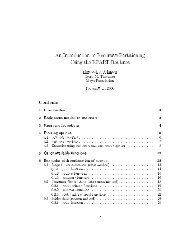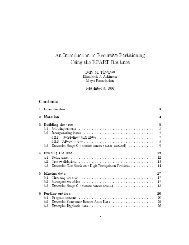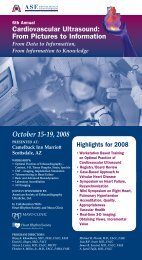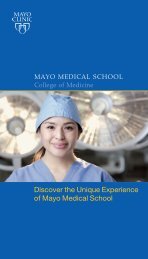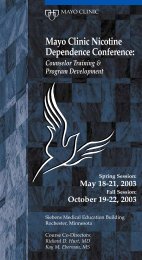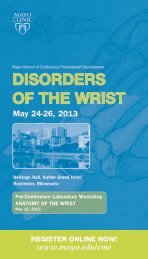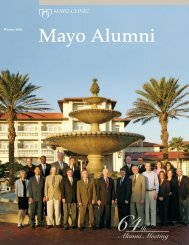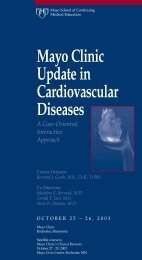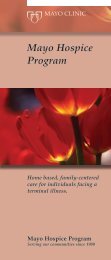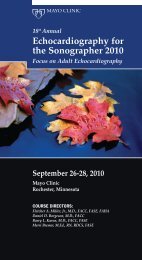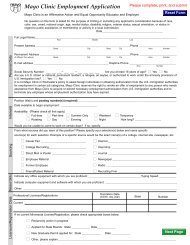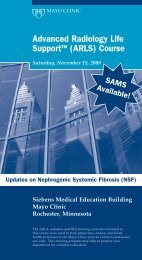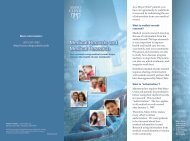Winter 2008-2009 - Mayo Clinic
Winter 2008-2009 - Mayo Clinic
Winter 2008-2009 - Mayo Clinic
Create successful ePaper yourself
Turn your PDF publications into a flip-book with our unique Google optimized e-Paper software.
“Our greatest challenge in enlisting alumni support<br />
for The Campaign for <strong>Mayo</strong> <strong>Clinic</strong> was to alert them about<br />
the financial shortfalls that lurk in the future,” says<br />
Dr. Soderstrom. “Philanthropy is no longer a ‘nice to have.’<br />
Instead, it’s a must-have if <strong>Mayo</strong> is to remain a leader in<br />
academic medicine. This message resonated well with<br />
alumni. Helping this institution to advance medicine and<br />
educate future physicians and scientists is something alumni<br />
are willing to support.”<br />
Miguel Cabanela, M.D., a consultant in Orthopedic<br />
Surgery at <strong>Mayo</strong> <strong>Clinic</strong> in Rochester and chair of The Doctors<br />
<strong>Mayo</strong> Society, says it’s impossible for <strong>Mayo</strong>’s practice to fund<br />
research and education. “Philanthropy is more important<br />
with decreased reimbursement and the economic climate,”<br />
says Dr. Cabanela. “Our alumni know that <strong>Mayo</strong> <strong>Clinic</strong><br />
opens its doors to everyone, so they’ve supported The<br />
Campaign for <strong>Mayo</strong> <strong>Clinic</strong>.”<br />
Dr. Soderstrom attributes this support, in part, to<br />
<strong>Mayo</strong>’s history of reaching out to alumni through hosting<br />
international meetings, welcoming visiting alumni home<br />
to <strong>Mayo</strong> campuses, and offering effective programs<br />
through the Alumni Association.<br />
“<strong>Mayo</strong>’s alumni have the deepest respect for the<br />
organization and proclaim that regardless where they<br />
practice, they are much better at their work because<br />
of their education and training at <strong>Mayo</strong> <strong>Clinic</strong>,” says<br />
Dr. Soderstrom. “They tell us they feel like part of a<br />
family. In surveys, they have reported that they have<br />
incorporated aspects of the <strong>Mayo</strong> model into their practices<br />
and that they have enduring reverence for everything<br />
<strong>Mayo</strong> represents. When they became aware of the need<br />
for support to ensure <strong>Mayo</strong>’s three-shield excellence is<br />
maintained for generations to come, they answered the<br />
call willingly and eagerly.”<br />
“Our alumni know that <strong>Mayo</strong> <strong>Clinic</strong><br />
opens its doors to everyone, so<br />
they’ve supported The Campaign<br />
for <strong>Mayo</strong> <strong>Clinic</strong>.”<br />
If you would like information about ways to support<br />
<strong>Mayo</strong> <strong>Clinic</strong>, including a particular area of clinical practice,<br />
research or education, contact Robert Giere, director of<br />
Alumni Philanthropy, giere.robert@mayo.edu, 800-297-1185,<br />
or a member of The Leadership Council for Alumni<br />
Philanthropy.<br />
On average,<br />
approximately<br />
10 percent of<br />
alumni give to<br />
<strong>Mayo</strong> <strong>Clinic</strong>.<br />
www.mayo.edu/alumni | 17



